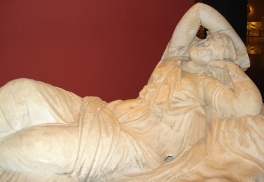
The Turkish Mediterranean is given scarce attention -- for no apparent reason. The coast is stunning, as rich in landscape as it is in ruins. The dolmus (small bus) took me from Fethiye, a town in the south-west of Turkey, to the town of Kas, winding along a coast nestled in hills, reminding me of the best curves of Route One on the Californian coast -- with blue-turquoise jewels of beaches ever so often.
I lucked into the idea of Kas, tipped off by university colleagues in Ankara as the place of choice for Turks in the know. And a fellow travel writer writing on "Trip Advisor" had alerted me to the best hotel in the region: The Hideaway, run by a happily glowing Belgian woman and her Turkish husband Ahmet. My room sparkled in white with a balcony overlooking the sea and rolling green hills of olive trees, with an ancient l00 B.C. Hellenistic amphitheatre a stone's throw away. Dinner was a barbecue of fish on the terrace as the sun set and we listened to Cat Stevens played by the barman cum DJ from Albania, who said he was "so happy to be in Turkey."
The next day it was hard to choose between the famed Patara beach to the east, birthplace of Santa Claus (long stretches of empty sand with ancient ruins nearby), and a boat ride to Kekova island (a yachting favorite) to the west. I was convinced by a girl who saw a boat in my "Turkish coffee cup" and chose the latter.
The boat cruised between islands of green until it came to the Sunken City, 2000 years old under the sea, where we could peer into the glass of the boat's bottom and see broken clay amphoras. Along the coast of the island were the stone remains of walls, staircases and a bathhouse -- all destroyed by an earthquake long ago.
We coasted on, with many stops to jump into pure blue water. The fact that it was April and hence there were no tourists in sight (the green islands humped on the water were deserted and quiet) made up for the fact that the water was refreshingly cold.
"Fantastic," said a Dutch woman who had just spent two years in Yemen, helping mountain villagers, wearing spears and guns, learn about "family planning." The guns, she added, were to make sure no one stole their spears.
"I love Turkey!" added an Iranian British girl on honeymoon, her eyes glowing as she put on an orange life-jacket to head for a kayak. "I feel at home here."
We ended our trip at a fortress: the ruins of Kalekoy.

The most important city on the Turkish Meditteranean is Antalya, sprawling for miles with modern skyscrapers -- a city surprisingly relaxed and carefree, with its wide bay facing the dreamy Bey mountains and laid-back feel. Crowds mulled in the sun along the main plaza in the old city, by the Roman harbor, drinking freshly squeezed carrot-orange juice and whipped toffee. Girls in jeans walked hand in hand with their boyfriends, talking on cell phones, while women in headscarves bounded along with baskets.
And as it happened to be national Children's Day (April 23rd, instituted by revered iconicized leader AtaTurk, founder of the country), parades of children with painted faces also passed along.
The most touristic section of Antalya -- the old town of Kaleici -- is worth a stroll, despite the shops selling babble blue evil-eyes. The carved wooden doors of the Ottoman mansions are welcoming, and the brick streets wind about and lead ever so often to a startling view of the sea, alongside a wide green well-trimmed park, where relaxed terrace restaurants overlook the cliffs.
I myself stayed in a former 18th century Ottoman mansion -- the Alp Pasa hotel -- which brings together the strange mix of modernity and antiquity that seems to typify Turkey: it boasts stubs of original Roman columns, unearthed statues of Hermes and Aphrodite from the Hellenistic period, Byzantine mosaics, and the wooden beamed ceilings typical of the Ottomans -- and in the center of the outdoor restaurant (where each client's table bears a flag disclosing their nationality) gleams a brightly lit swimming pool.  http://www.alppasa.com
http://www.alppasa.com
